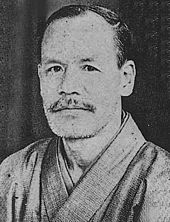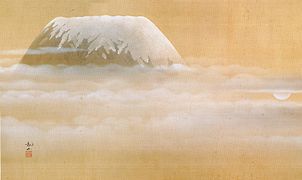Shimomura Kanzan
Shimomura Kanzan ( Japanese 下 村 観 山 ; born April 10, 1873 in Wakayama ; died May 10, 1930 , real name Seisaburō ( 晴 三郎 )) was a Japanese painter of the Nihonga direction.
life and work
Kanzan's ancestors had long been Nō musicians in the service of the Kishū Tokugawa . In 1881 the family moved to Tokyo, where his father made a living doing die cutting. Kanzan began studying art under Kanō Hōgai and Hashimoto Gahō . From 1889 he studied at the newly founded "Art Academy Tōkyō" ( 東京 美術 学校 , Tōkyō bijutsu gakkō ), the forerunner of the Tōkyō Geijutsu Daigaku , which graduated in 1894. The director of the school, Okakura Kakuzō , then appointed him as a lecturer at the school.
Shimomura won silver medals for works that he showed at the exhibitions of the "Society for Japanese Painting" ( 日本 絵 画 協会 , Nihon kaiga kyōkai ). When Okakura angrily gave up the management of the art academy in 1898, he followed him together with other artists on Okakura's new founding, the private art school Nihon bijutsu-in . In the exhibitions held there, he won a gold or silver medal several times.
In 1901 Shimomura took over a teaching position at the art academy again. At the beginning of 1903 he was sent by the Ministry of Culture as the first painter of the Nihonga direction to Europe for two years, where he mainly dealt with watercolor painting in England, but also Belgium , France , Italy , the Netherlands and others. a. Countries visited. At the end of 1905 he finally returned to Japan. When the Nihon bijutsu-in was relocated to Izura in Ibaraki Prefecture for economic reasons , he followed there, together with Yokoyama Taikan and Hishida Shunsō. The three worked together, creating pairs of scrolls several times.
In 1907 Shimomura was appointed by the Ministry of Culture as a consultant for the state art exhibition (abbreviated as Bunter ) organized by the Ministry . His work "Autumn under Trees" ( 木 の 間 の 秋 , Ko-no-ma no aki ) exhibited there attracted attention. In 1908 he left the state art academy again. In the same year he showed the picture role "Visit of the Emperor in Ōhara" ( 大 原 御 幸 , Ōhara gokō ) in the exhibition of the art society Kokuga gyokusei-kai ( 国画 玉成 会 ).
In 1910 and 1911 he was a member of the jury of the Bunten exhibition. In 1912 he moved from Izura back to Tokyo. In 1914 he refused to continue to work as a member of the jury for the colorful exhibition. Instead, he tried to reactivate the Nihon bijutsu-in in Tokyo together with Yokoyama and Yasuda Yukihiko . Here he continued to work with Yokoyama to advance the development of Nihonga. His most famous work, his pair of adjustable screens “ Begging Monks ” ( 弱 法師 , Yoro-boshi ; 1915) and Okakura's posthumous portrait entitled Tenshin sensei ( 天 心 先生 , 1922, burned), which were shown at the Nihon exhibitions, date from this period bijtsu-in were shown. In 1917 Shimomura was appointed a "member of the Imperial Chamber of Artists" ( 帝室 技 芸 員 , Teishitsu gigei-in ).
Shimomura had dealt with the Yamato-e , had studied the Rimpa School, the painting of the Song period , but also European painting. He had extensive knowledge of Buddhism, literature, and biographies, from which topics could be used for his works. In this way, he influenced the next generation of painters, especially Maeda Seison (1885–1977).
photos
"Beggar Monk", 1915 ( important cultural asset )
literature
- Mainichi Shimbun-sha (Ed.): Yokoyama Taikan to sono doshintachi. , Mainichi Shimbun-sha, 1992.
- Tazawa Yutaka: Biographical Dictionary of Japanese Art . Kodansha International, 1981. ISBN 0-87011-488-3 .
- Laurance P. Roberts: A Dictionary of Japanese Artists. Weatherhill, 1976. ISBN 0-8348-0113-2 .
Web links
Remarks
- ↑ Izura ( 五 浦 ) is a coastal district of Kitaibaraki .
- ↑ Main character from a Nō play of the same name.
- ↑ Based on Okakura's opera libretto The White Fox , which appeared in English in 1914 and which was dedicated to the art patron Isabella Stewart Gardner .
| personal data | |
|---|---|
| SURNAME | Shimomura, Kanzan |
| ALTERNATIVE NAMES | 下 村 観 山 (Japanese); Shimomura Seisaburō (real name); 下 村 晴 三郎 (Japanese, real name) |
| BRIEF DESCRIPTION | Japanese painter of the Nihonga direction |
| DATE OF BIRTH | April 10, 1873 |
| PLACE OF BIRTH | Wakayama |
| DATE OF DEATH | May 10, 1930 |




